Eternal Inflation and the Multiverse Controversy
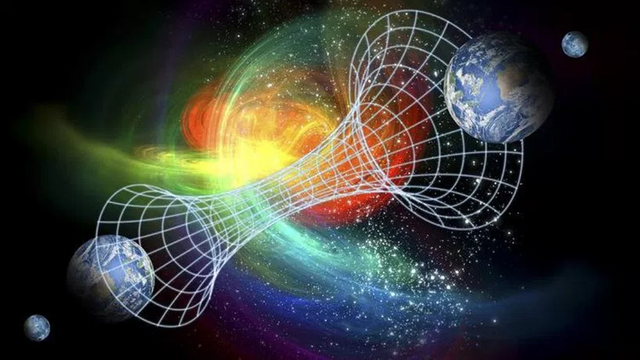
Some scientists think that the universe began with a singularity - an infinitely small volume with an infinite density of energy. Others, and in particular Steven Hawking and his followers, believe in quantum tunneling from nothing. We only know one thing: the universe once began. And at some point in time in the past, it was in a state with a very high energy density and, perhaps, underwent an inflationary expansion. Almost all cosmologists "believe" that the hypothesis of the inflationary stage of the expansion of the universe explains very well many cosmological riddles. In Chapter 4, I already talked about the observational facts underlying this belief.
We are all confident that the observed history of our universe began about 14 billion years ago at the point of the Terrain, where the energy density was sufficient to ensure an inflationary expansion of the space of at least 10-20 times. And this value, it is quite possible, is underestimated. The density of energy in this era was incredibly huge - we can not say how huge, but certainly incommensurably more than the energy density achievable in the most powerful accelerators of elementary particles.
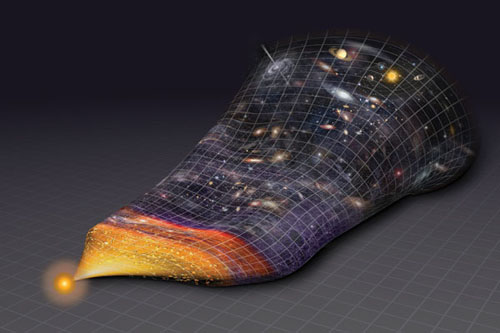
Apparently, at that time the universe was not yet trapped in one of the Landshaft valleys, but rested on a relatively smooth and canopy plateau. In the process of inflation, our pocket of space (our observable universe) slowly moved along this plateau, which had a slight slope, to a steep cliff at its end. When the fall from the cliff, the potential energy of our Universe was transformed into heat and elementary particles, giving rise to matter, from which stars and galaxies subsequently formed. This event, in which the universe is filled with matter, is called reheating. After that, it slid down to the bottom of our valley with a cosmological constant that was tuned to a convenient for our existence. All our cosmology refers precisely to this short period of the fall of the universe from one value of the vacuum energy to another. It was during this period that all the most interesting events in the history of the observed universe occurred.
How did the pocket from our universe end up on the edge of the cliff? This we do not know. But it is very convenient to assume that the universe began here. Without inflation caused by a high energy density on the plateau, the universe could not evolve into that universe filled with matter that surrounds us: large enough, fairly smooth, fairly homogeneous and at the same time having the degree of heterogeneity that is best suited for the emergence of life.
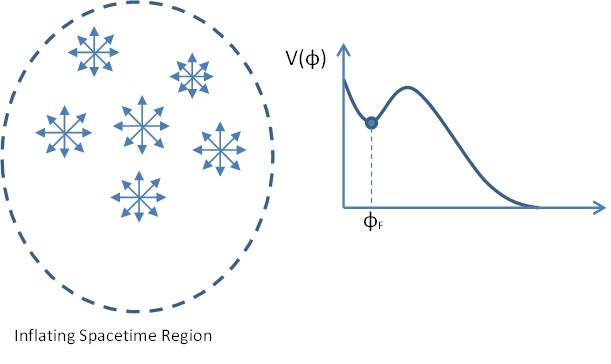
The problem of the theory, which puts us at the beginning of time on the edge of the cliff, is that this is just one of the colossal number of possible starting points. The only difference between this point and the others is that it provides a potential opportunity for the development of life. The accidental placement of the Universe in such a successful point of the Terrain is not the best argument for the researcher who wants to explain the origin of our world without appealing to the concept of intelligent design. But, as I will discuss later, a theory containing a giant landscape does not require any choice. In my opinion, it is absolutely inevitable, moreover, it is mathematically demonstrable that if the landscape is very diverse, then there is always such a part of space that evolves into a favorable point of the Terrain. But not everyone agrees with this.
Princeton cosmologist Paul Steinhardt, in order to criticize the anthropic principle, said: "The anthropic principle allows for a huge number of assumptions related to the existence of a multitude of universes ... Why all these hypotheses about the existence of an infinite number of universes with many different properties? Is it only to explain the existence of our own? "The answer is that we do not need to state any unreasonable hypotheses - they naturally follow from the universally recognized principles of the theory of relativity and quantum mechanics.
This is paradoxical, but in his own work Steinhardt formulated the germ of the idea of eternal inflation, and there he gave arguments that, from my point of view, suggest that eternal inflation is inevitable. The universe is infinitely divided into pockets that appear as bubbles in a just-opened bottle of champagne. There are only two assumptions about why this happens: because of the existence of the Terrain and because the universe began with a state with very high energy density, or, which is the same thing, at a high altitude of the Terrain. And the first assumption, apparently, can be proved mathematically, and in this sense it is not at all an assumption. Everything goes to the fact that the existence of the Terrain inevitably follows from the mathematics of string theory. As for the second assumption, the high initial energy density is practically an observable fact, it manifests itself in the form of the same Big Bang, from which any self-respecting cosmology begins.
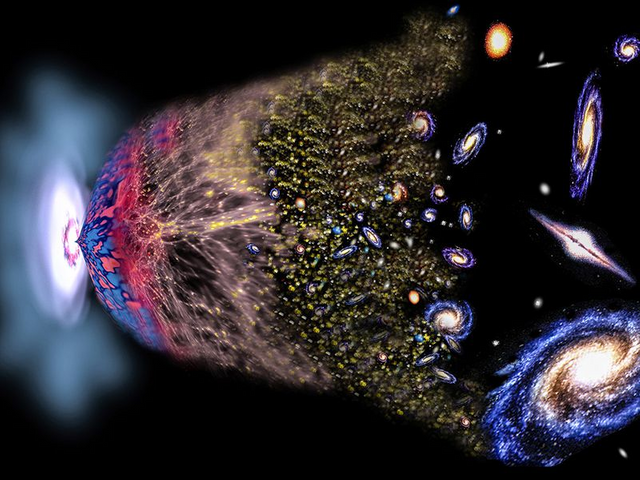
Let me explain why I, along with most other cosmologists, find the idea of perpetual inflation very convincing. First of all, I must admit that this is not my idea. It was first voiced by cosmologists Alan Gut, Andrew Linde, Paul Steinhardt and Alexander Vilenkin, and then developed by one of the greatest physicists of my generation Sidney Coleman. So, let's start with the universe, or even just from the area of space located at an arbitrary point in the Landscape. The only requirement to this point is that the energy density in it must be sufficiently large. Like any mechanical system, our area of space will begin to evolve towards that part of the Terrain where the potential energy is lower. Imagine a bowling ball rolling from the top of Mount Everest. What is the probability that it will come to the coast of the Indian Ocean, and not get stuck somewhere along the road? To put it mildly, it is not too high. It is much more likely that the ball will rest in a valley near the mountain. And knowing the initial conditions - the exact place from where the ball began to roll, and the exact value of its initial speed - is unlikely to help us predict where it will be stuck.
Exactly what happens to the bowling ball will happen with our area of space: most likely, it will fall to the bottom of some valley, where it will start to swell. In the process of this inflation, enormous volumes of space will be cloned, and all of it will remain in this valley. Of course, there are other valleys below that in which our space bubble has stuck, but to reach them, the Universe will have to climb over mountain passes, the height of which is much higher than the height of the valley, and she will not be able to do this, because she already has there will not be enough energy. Therefore, our universe will forever remain inflated in its valley.
But we forgot one thing. Vacuum is inherent in quantum tremor. Just as the thermal shudder of supercooled water causes the spontaneous emergence and disappearance of condensation centers, the quantum quake of the vacuum gives rise to small bubbles of an alternative vacuum, which immediately disappear. The interior of these bubbles can correspond to the conditions of the neighboring valley, which lies below ours. The formation of bubbles occurs constantly, but for the most part they are too small to grow further. The surface tension of the blast wall separates the bubble from the rest of the vacuum and compresses it. But, as in the case of supercooled water, sooner or later a bubble will form in our space, which will be big enough to start growing.
The mathematical description of the formation of such a bubble in the inflationary universe has been known for a long time. Back in 1977, Sidney Coleman and Frank de Lucia published an article that was destined to become a classic. They calculated the speed with which such bubbles will arise in the inflationary universe, and although the velocity (the number of bubbles produced per unit of time per unit volume) can be very small, it certainly is not zero. In their calculations, only the most reliable and proven methods of quantum field theory were used, methods, according to the beliefs of most physicists, reliable as a rock. Thus, unless there is something terribly wrong in our fundamental theories, an inflationary vacuum must generate growing bubbles, the conditions within which correspond to conditions in neighboring valleys.
Can a collision of bubbles lead to the fact that eventually the entire space of the universe will be in one of the neighboring valleys? Or, in other words: is the space widening between the bubbles fast enough to prevent their collision and fusion? The answer depends on the competition between two parameters: the speed of the bubble formation and the speed of reproduction of the new space - the speed of cloning. If the bubbles grow very quickly, they will collide and eventually the whole space "overflows" into a new valley in the Landscape. But if the speed at which a new space is generated is greater than the speed at which bubbles grow, inflation will win and bubbles will never meet with each other. Like ice islands in the overflowing lake, the bubbles will develop in isolation and eventually end up outside the horizons of each other's events. The main part of the space will continue its eternal inflation.
So what wins: bubble nucleation or cloning of space? In general, the question remains open. Bubble nucleation, like all other tunneling processes, is a rare and unlikely event. As a rule, in order to create a bubble large enough not to collapse back, but to begin to expand, a very, very long time must pass. On the other hand, the speed of cloning space, that is, its exponential growth due to the vacuum energy, is extremely large, unless the cosmological constant is negligible. In most cases, except for very far-fetched, the space continues to clone itself exponentially, while bubbles slowly appear in the neighboring valleys of the Terrain. Cloning space wins in our race with a huge margin.
Now let's look inside one of the bubbles. What will we see? Most likely, we will find ourselves in a valley, the height of which is somewhat less than the height of that valley from which we looked inside. The space inside the bubble is also growing. I do not mean simply expanding the bubble, but cloning the space inside it. Thus, the story will be repeated again and again. A new area of space is currently located in a new valley. But there are other valleys, located even lower. Inside the first-generation bubble, a second-generation bubble can form, the space within which will match the lower-lying neighboring valley. And if this bubble turns out to be larger than the critical size, it will start to grow, and we will get a growing bubble inside the growing bubble.

Usually I try to avoid biological analogies in physics, because people tend to take them too literally. But I still use one of them. Only, please, do not think that I believe that universes, black holes or electrons really are alive and participate in Darwinian selection or have sex.
Imagine Megaversum as a colony of organisms that are reproduced by cloning. I emphasize once again that under the word "organism" I understand not a living being, but a self-reproducing area of space. Because the clones are identical to their parents, we are right to assume that they are located in the same valley of the Terrain. One can even imagine the landscape itself as a set of biological organisms: each valley will correspond to a separate biological species. You can not worry about the fact that organisms will interfere with each other: in our imaginary world there is more than enough room for everyone. As soon as a bubble with properties different from the properties of the space that created it is formed, its offspring immediately occupy the neighboring valley. As the space inside the bubble also inflates, its offspring will participate in two processes: during cloning and in the process of settling new valleys by generating a new generation of bubbles.
In this way our metaphorical colony will spread throughout the Land. The regions of space located in higher valleys where the cosmological constant is of greater importance will be reproduced most quickly. In such places of the Landscape the process of cloning is going on at the fastest pace, and the populations "living" in such valleys grow fastest. But organisms living in higher valleys "feed" the lower valleys, and the population of the latter also grows with time. An interesting and important issue is the possibility of the existence of "stairs" in the Landscape. In other words, can any of our fictitious organisms rise to a higher valley? The answer, dictated by the rules of quantum mechanics, is affirmative: anything that can happen can happen in the opposite direction.
Eventually, each niche in the Terrain will be filled with an exponentially growing population. The only thing that lags this analogy is that real organisms start killing each other in the course of competition when their valley becomes overpopulated. Pocket universes lack a mechanism of competition, so the population of each valley will continue to increase indefinitely. One could imagine these organisms as completely invisible and insensible to each other.
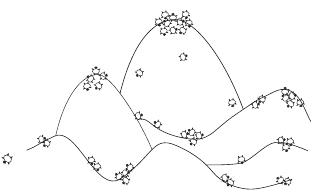
How do bubbles die? If a bubble appears with a precisely zero cosmological constant, it can not swell, and the process of reproduction on it will be interrupted. Only such vacuums are supersymmetric parts of the Terrain. Thus, the supersymmetric regions of the Terrain are cemeteries of universes in at least two senses. First, life in a form known to us can not exist in supersymmetric worlds, and secondly, such a space can not generate new bubbles. Analogies often help to gain a deeper understanding of one side of the question, but they turn out to be incorrect when considering the whole issue. Thus, the analogy between the inflating space and the evolution of living beings turns out to be incorrect in separate details, for example, that among the bloating bubbles there is no competition, which is always inherent in evolving biosystems.
In addition, Darwinian evolution involves the inheritance of traits from parents to descendants. If we could build a series of photos of primates, starting from the notorious "missing link" five million years ago and ending with me or you, you would see a continuous series of changes in signs. If we ignore the individual differences of individual individuals, we will be surprised at how much each next generation looks like the previous one. Only the changes that have been accumulated for more than a thousand generations will be noticeable when looking at these photographs. The same will be true for all types of life. Large structural changes occur very rarely, and when they arise, they almost always lead to an evolutionary impasse. Any person born with two heads, three legs or without kidneys will not survive for a long time (unless one invites modern medicine to help), and such creatures have very little chance of leaving competitive offspring.
This is the radical difference between biological evolution and the evolution of the cosmic landscape. The change in the landscape that occurs when the bubble is created and inflated does not have an incremental character. Let's look at this process from the point of view of geology. Geologically, the neighboring valleys are different. The Valley of Aspen Valley in the Rockies lies at an altitude of 2,400 meters, which is more than 600 meters lower than the Double Lakes on the other side of the Independence Pass. In addition to the difference in altitude, these places differ in their nature. If there is another valley, so similar to Aspen Valley, that we, being in it, would not notice the difference, then, most likely, it is located very far from it. The same applies to the space landscape. The heights of neighboring valleys are not exactly the same. And this can lead to the fact that neighboring valleys will differ in the set of branes or streams, which in turn will lead to differences in the list of elementary particles, other values of fundamental constants and even the dimensionality of space. When the vacuum parent spawns a posterior bladder, the result is a rather monstrous mutation, rather than a small incremental difference.
Is not it eternal inflation, which generates innumerable bubbles of new worlds of all kinds, a wild phantasmagoric hallucination? I do not think so. The exponential expansion of space seems to be a fairly established fact, which no cosmologist disputes. The possibility of the existence of more than one valley is in no way unusual from the theoretical point of view, just as there is no doubt that swelling bubbles will roll down in regions lying at a lower altitude. Today it is universally recognized.
The new is that string theory gives us a mathematical justification for the possibility of the existence of a huge number of valleys with various vacuum properties in them. Many physicists are very worried by this fact. But the most serious string theorists recognize that this argument looks solid enough. Consider the last stages of the cosmic evolution of our fragment of space, immediately preceding the modern era of inflation, the subsequent warming up and the emergence of life. Where did we come before we fell from the inflationary cliff? The most reasonable answer: from a neighboring valley, lying at a higher altitude.
How is this valley different from ours? String theory is also capable of answering this question: the flows had different meanings, the branes were arranged differently and the compactification modules differed from ours. Perhaps during the hike through the mountains to the cliff, some of the branes annihilated with each other, and the rest were rebuilt, the flows shifted, and hundreds of modules changed to create a new version of the Rud Goldberg machine. And with the new order came the new laws of physics.

References for Text and Images
- https://www.nature.com/scientificamerican/journal/v23/n3s/full/scientificamericanuniverse0814-68.html
- https://www.scientificamerican.com/article/multiverse-controversy-inflation-gravitational-waves/
- https://physics.stackexchange.com/questions/29559/the-multiverse-of-eternal-inflation
- https://www.nature.com/scientificamerican/journal/v23/n3s/full/scientificamericanuniverse0814-68.html
- http://universe-review.ca/F02-cosmicbg10.htm
- https://www.newscientist.com/article/2063204-mystery-bright-spots-could-be-first-glimpse-of-another-universe/
Support @steemstem and the #steemstem
project - curating and supporting quality STEM
related content on Steemit

Good information thanks.
Wow
Superb information! Interesting how we can measure the universe from the big bang and how the energy point was highly concentrated before the big bang. The part you mention about the bubbes and cloning it reminded me of the flower of life:

Going to #resteem this for sure!